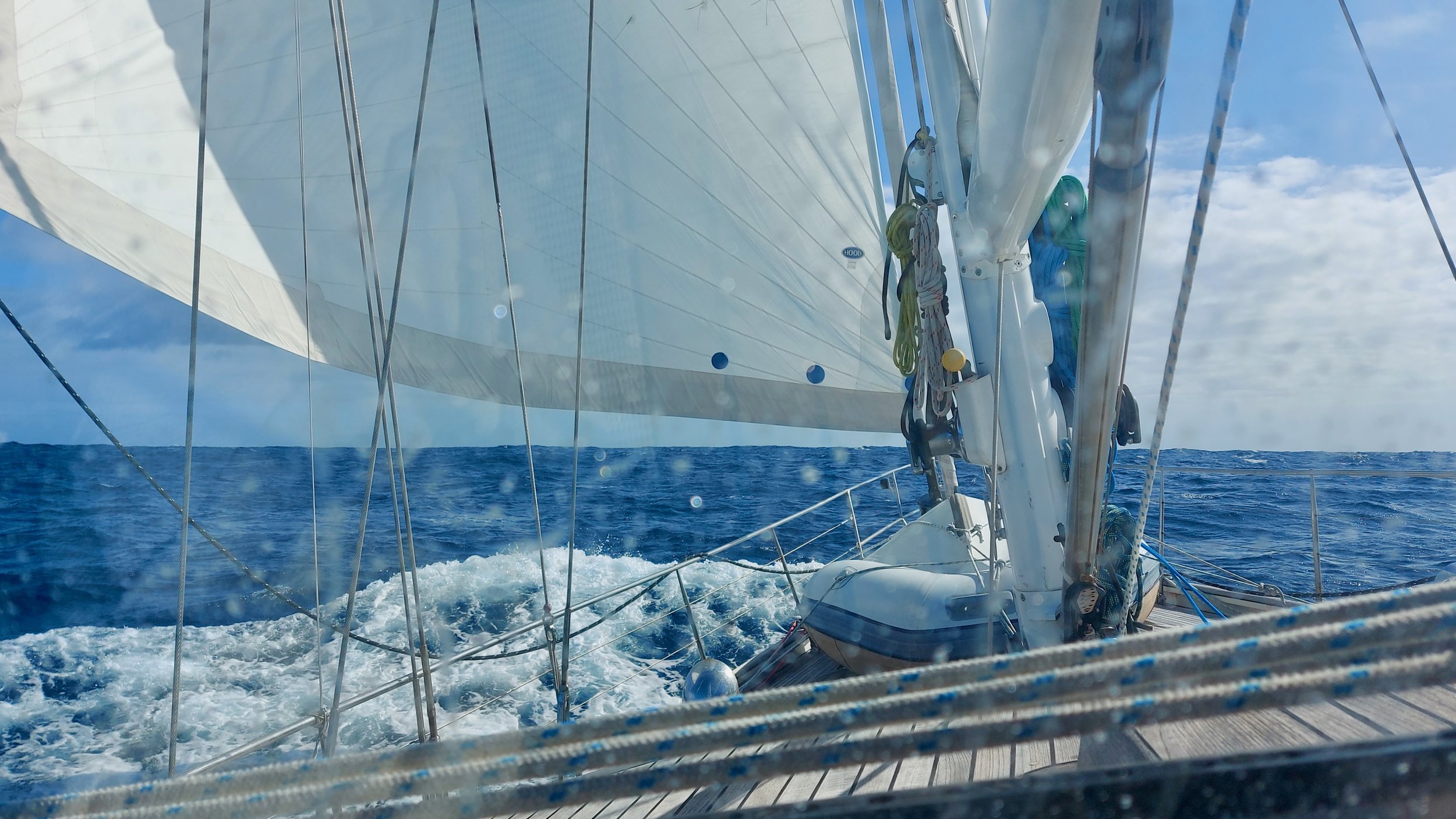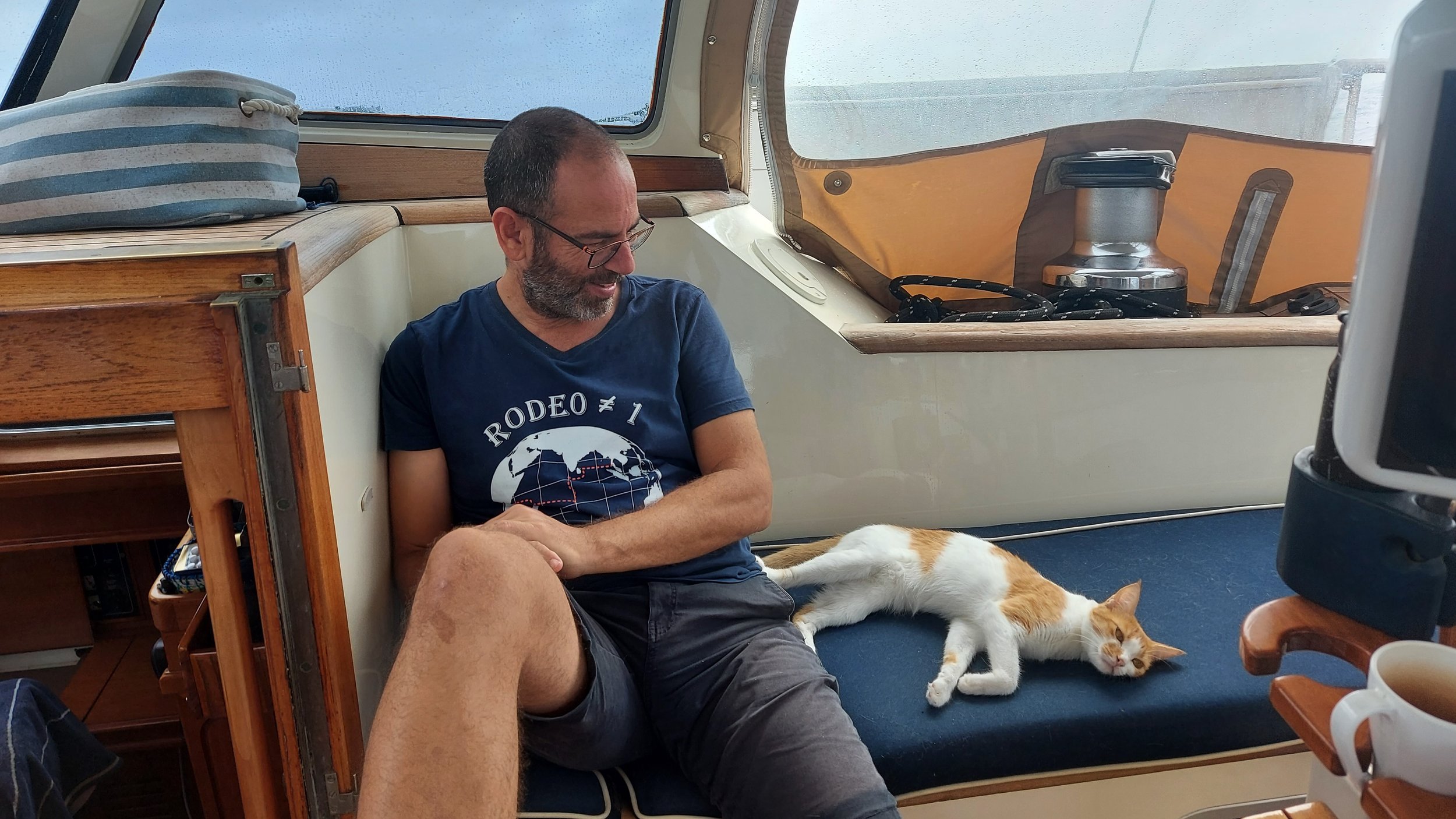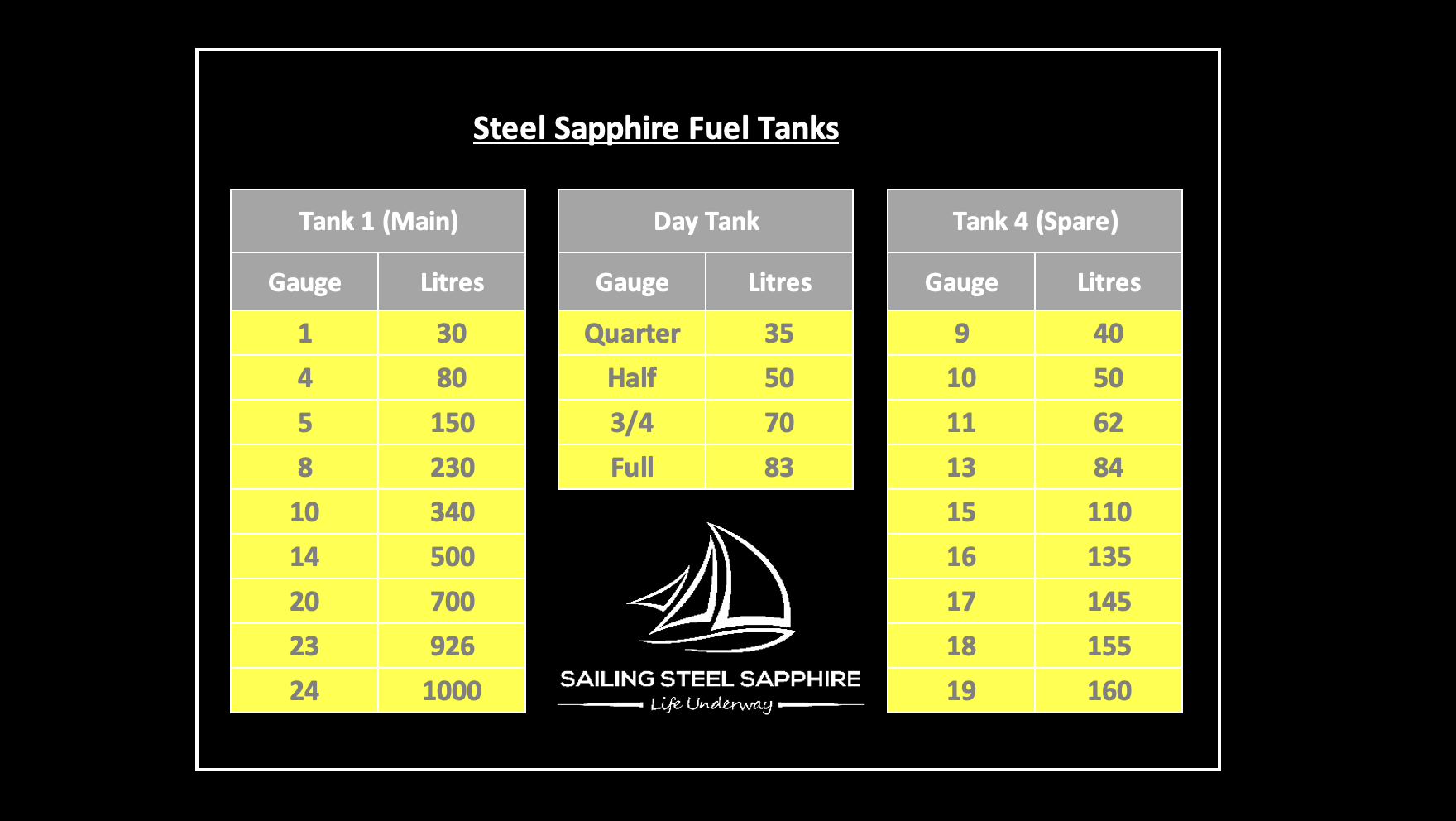Departing Azores with Mixed Emotions

Day 1 : Azores to Ireland
Wednesday, May 18th 2022
We dropped the lines at 12 noon yesterday, with very mixed emotions.
On the one hand, we are excited to be starting the last of the major legs on our Atlantic Odyssey. So far, we’ve sailed 6,680 miles from Cape Town in late January, and with approximately 1,200 miles to go on this leg, it will be close to 8,000 miles in 4 months – that’s intense cruising by most standards.
We’ve been on a mission, of course, to get back to the UK for my 50th, and my Mum’s 80th birthdays, and it looks like we’re going to make it…kind of. But more on that later.
We were also feeling a little nervous as we set sail. That’s to be expected before any long ocean passage, but this departure felt particularly daunting, as the wind was howling, and the marina we were in offered little protection. So we were quite clear that as soon as we were out from behind the breakwater, we’d be in the thick of the Atlantic Ocean in near gale conditions. The intense wind and waves were forecasted to die out as the day progressed, but if we were to make the most of the weather window that was presenting itself, we needed to get underway on the tail end of the storm that has been passing through Azores over the last few days.
Sadly, there was also some regret in the mix too. The Azores are a special place, and we had hoped to see a lot more of them. In truth, most cruisers who arrive here stop only in Horta, on the island of Faial – it’s a perfect staging post for those making West to East Atlantic Crossings, and is a charming town, on a beautiful island, with good facilities for repairs and a well protected marina (just about the only one in the 9 islands that offers good protection). But we’ve watched the YouTube vlogs from a few of our favourite channels who have come here over the last couple of years, and were inspired to visit the other islands as they had done.
In truth, it was a significant contributing factor to us deciding to head to the UK “the long way” via Cape Town and the South and North Atlantic, rather than the Red Sea, which we were just days away from embarking on last year.
But the realities of cruising caught up with us, I’m afraid.
The intense pace and major miles meant that we arrived in the Azores with a fair number of maintenance and repair projects to undertake. The steering failure was our number one priority, of course, and we took our time with that to ensure that we not only repaired what broke, but improved the system to make it less likely to ever occur again. In doing so, we found some other problems in the steering system which may or may not have been caused by the failure we did experience (the reduction gearbox mountings had cracked and it was beginning to move with every steering movement). We’re very glad we spotted it, as it would have been impossible to repair underway if it had totally failed in the middle of the ocean.
We took the opportunity to service all three engines, and also to open up, clean and repair one of our stainless steel water tanks, which had started to bang alarmingly on the last passage. One of the baffles had come loose on the inside and needed to be re-welded. That tank has not been opened since the boat was built 28 years ago, so we feared what we might find inside, but in truth it was pretty much pristine – just some rust streaks from where the welds on the baffle had failed, so although it was a time consuming job, it was ultimately a very satisfying one.
In amongst that, we did get to sight-see around Faial and the neighbouring island of Pico, so we were pleased with the balance of part 1 of our Azores trip. We also got to enjoy a steady stream of sexy boats arriving and departing form Horta. May is the “shoulder” season for the mega-yachts that cruise the Caribbean and the Med, so every day yet another 150 foot plus sailboat would arrive with their delivery crew, bound for summer in the Med.
Included among those were Ranger, Velsheda and Svea, three of the magnificent “J-class” boats from the heyday of the America’s Cup in the 1930s. It’s no exaggeration to say they are by many sailors’ standards the most jaw-droppingly beautiful yachts ever built. Search for “Svea J-Class” on YouTube and you’ll see what I mean.
We took the opportunity to chat to crew on Ranger, and the Captain on Svea, and that alone made our trip to the Azores worthwhile for me personally.
After two weeks there, we sailed 150 miles to the capital, Ponta Delgada on the island of Sao Miguel. We had paperwork for Coco and also a new chart plotter waiting for us there, plus it was an opportunity for us to test the new steering setup before taking on this last major passage, so we were glad to make the trip.
But Ponta Delgada was to be a disappointment.
The island itself is reputed to be beautiful, but we never got to find out. Despite it being the capital, the marina was very poorly protected - the surge was ever present, even when the winds were calm. And then once the low pressure of the last few days blew through, it became ridiculous. We snapped one 22-inch high-stretch mooring line, and chafed through 4 separate lengths of hose that we were using for anti-chafe protection.
At one point on our final night, I considered dropping the lines and heading out to sea just to escape the snatching and creaking and groaning inside the marina!
While we were there, vanity got the better of us, and we decided to do a little corrosion repair on our cabin top while we were waiting for a good weather window for our onward sail.
Until this point, all of our boat jobs were essential – either fixing things or preventative maintenance. But this one was a little different. We had our cabin top professionally repainted in Thailand three years ago, and ominous signs of rust had appeared back in Cape Town. It didn’t seem too bad then, so we left it as something to tackle in the UK, but by the time we arrived in Azores, we had unsightly orange streaks all the way around the cabin top, forward of the mast.
With vision of our impending “triumphant” sail up the River Clyde to my home port of Largs just a few weeks away, and I felt it would be worth taking a day or two to make the boat look less like a rust bucket. Jen knew that I was delusional if I thought it could be done so quicky, but agreed that it looked ugly and reluctantly was persuaded to tackle the project (rust removal and painting is her department – I help as the Trade Assist, but Jen is much more painstaking than I am with this type of job, so always takes the lead).
There were a couple of areas where the paint had bubbled and cracked, but on closer inspection, it became clear that the wrong sealant had been used between the teak deck and the cabin top, and UV had taken its toll, degraded the sealant and allowed moisture to come in all the way around the cabin top.
So the small job (which Jen knew was actually a medium to large job) actually turned into a monster job, involving removing all the failing Sikaflex, grinding giant gouges out of the cabin top to get rid of all the rust, applying rust converter, two coats of primer, fairing in the holes, lots of sanding down of the fairing compound, two more coats of primer, three coats of topcoat paint, and then replacing all the Sikaflex the entire way around.
Jen did an amazing job, and I couldn’t be more proud or impressed. Who knew I was marrying a shipwright? And I was amazing at mixing the paints, and passing the rags and tools too
By the time the job was completed, the big winds had arrived and we didn’t feel comfortable leaving the boat unattended in the crazy marina.
Throughout this period, we’d been watching the weather forecasts closely. The North Atlantic can be a fearsome ocean at times and can be completely benign at others - it’s all about choosing you weather windows.
Given that we had a deadline of sorts (end of May for my birthday, and mid June for my mother’s), we had targeted 10th May to be ready for the 10 day sail to Falmouth. That gave us an extra 10 days up our sleeves to wait for weather. But even then, we knew that it might take much longer. June and July are the best months to sail to the UK form the Azores, so we are just a little early in the season.
And in the meantime, our plans changed somewhat. We’ve always been aware that you cannot bring a pet into the UK by private boat – they have to be flown in. So our intention was always to put Coco on a plane in Sao Miguel, and then meet her at the other end, prevailing on friends or family to look after her in the meantime.
But a Skype call with Glenn and Lynn, former owners of Steel Sapphire, to discuss the steering issues and get their input, became serendipitous when they let us know of an unlikely loophole in the Pet rules. It turns out that since there is no land border between the Republic of Ireland and Northern Ireland, the UK allows duly certified pets from Ireland to make their way into the UK without inspection or quarantine, including by private boat! So all we needed to do was make Coco legal in the EU (which we had to do anyway to fly her), then it would be straightforward to land her in Ireland (also part of the EU), and then sail onwards.
So at a stroke, Falmouth was out of the window, and Cork was to be our new destination. And from there, we’d already decided we would be sailing up to Scotland, and spending a month or two up there before sailing down to London.
As time ticked on, though, we were starting to become concerned that the right window was never going to appear. Either it was too stormy, or not enough wind, or wind in the wrong direction. We knew there was no need to rush things - in the worst case scenario, we could just leave the boat in the Azores and fly in for my mum’s birthday (we are pretty comfortable to celebrate mine wherever we happen to be) before returning in late June to sail the boat to the UK.
But just when we thought we might have to start looking at flights, the clouds metaphorically parted, and the window appeared. By yesterday morning, the immediate forecast was looking as good as we’ve seen it for a while - still not perfect, but good enough.
The decision was made.
We were expecting a spicy start, and we duly received it. It was blowing 25, gusting 30 as we eased out of our berth, and as soon as we exited the harbour, we were straight into 3m seas on our starboard quarter.
A couple of squalls with gusts up to 46 knots had us questioning our sanity, but we knew that after the first hour or two, we could bear away and put the swell directly behind us which made things much more comfortable. Plus with us now on a broad reach, the wind could do what it liked and we could simply adjust the Genoa at will to keep us appropriately canvassed.
As per the forecast, we now have force 3-4 on the beam, although we still have those annoying 3.5m seas to content with. They should lay down tomorrow thankfully.
After that, ECMWF (the model we have most confidence in) says we’ll have another boisterous day on Thursday (force 5-6), then no wind over the weekend, and then a nice close reach (force 3-4) all the way to Cork.
To get the nice wind for the last 500 miles, we’ll need to motor through that calm patch, but we’re happy enough doing that.
As we woke up yesterday, we were considering letting this weather window go, and hoping another one would appear in a week or so, to give us time to explore more here. But the birthday celebrations, and just general excitement at sailing to the UK, were calling us.
____
Day 1 Statistics:
Time on passage so far: 20 hours
Distance covered in first 20 hours: 123 nm
Average Speed in first 20 hours: 6.2 knots
Distance to go: 1,022 nm
Number of times Coco threw up in the first 20 minutes – 7 (we think it was nerves rather than actual seasickness. It really was an intense start as we left the marina and straight into huge seas and strong winds. But even though she doesn’t know it, she could have been in the hold of an airplane. So this has got to be better, right?)





